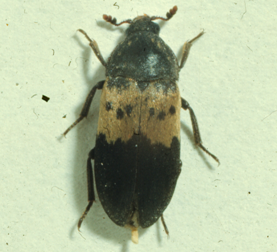
Phil Pellitteri, UW Insect Diagnostic Lab
Revised: 4/27/2004
Item number: XHT1051
Adult larder beetles (Dermestes lardarius) are 1∕3 inch long black beetles with a broad, pale tan, black spotted band across the front portion of the wing covers. Larder beetle larvae are reddish brown and densely covered with short and long hairs, and have two curved spines on the top of the tail end. Both adults and larvae feed on high protein food sources including cured and spoiled meats, dried fish, high protein pet food, dead insects such as cluster flies and boxelder bugs, furs, feathers, leather, cheeses, dead rodents and birds in chimneys or wall partitions, and even rat or mouse poison baits. Larder beetles are a type of carpet beetle, but they only attack woolens that have been soiled with blood, fish oils, or other high protein stains. Close relatives of the larder beetle are used to clean the flesh from skeletons used in museums.
Life cycle:
Larder beetles overwinter as adults in protected places. In spring adults are attracted to areas that have suitable food. Females can lay over 100 eggs, which take about two weeks to hatch. Larvae will feed for 40-50 days on high protein food before pupating (transforming) into adult beetles. The total larder beetle life cycle takes about two months.
When larvae are searching for a place to pupate they have a habit of boring into wood and other hard materials. One reason larvae seek such protected sites is to avoid cannibalism during the pupation period. Larvae can easily chew through paper, light plastic, cork, and tin, or into foam insulation. Structural problems have occurred in poultry and mink operations that have undisturbed, protein rich food sources.
Control:
The first step in larder beetle control is to identify and dispose of the beetle’s food source. Without a food source, larder beetles will not survive. An infested bag of dog food is easily cleaned up. However, finding the source of one or two beetles may be very difficult. Adult larder beetles are attracted to night-lights or may breed on a small food source such as a dead mouse. If larder beetles and their larvae are found in high numbers or have been a reoccurring problem, a large food source or a renewable food source, such as dead cluster flies (see UW-Extension bulletin A2090) or boxelder bugs (see University of Wisconsin Garden Facts X1100) in the walls, may be the underlying cause. Knowing why you have the problem will lead to a solution.
If the food source appears to be within a wall, letting the problem run its course is likely the best solution. When the larder beetles have exhausted the food source they will disappear. If beetles and larvae fall through light fixtures into the living space, they can be vacuumed or swept up if numbers are small. Taping or screening access points will reduce this type of nuisance. Homes also can be sealed to prevent cluster flies and boxelder bugs from entering. Caulking, screening, and sealing openings will keep these insects out off wall voids and attics.
Cleanup of the food source is always the best approach to controlling larder beetles. However, if the food source cannot be identified, spraying baseboards, around electrical plates and other access points into walls with any indoor ant spray will kill the beetles that come into contact with the spray. Because larvae and adults migrate from the food source it is not always effective to just spray the site where insects have been found. For infestations located in foam insulation, dust or powder type insecticides are preferred. The solvents found in many liquids may melt insulation. Insect bombs are ineffective in controlling larder beetles, because they do not penetrate into walls. Sonic devices also do not work and there are no reliable repellents.
Heating objects to 130°F for two to three hours, or placing objects in a deep freeze at 0°F for 24 hrs, will kill larder beetle adults and larvae in objects or pet food. Storing pet food in tight fitting plastic container also will provide protection and help confine existing infestations.
Download Article





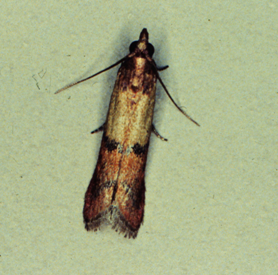 Indian Meal Moth
Indian Meal Moth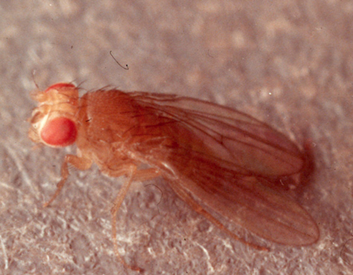 Fruit Flies in the Home
Fruit Flies in the Home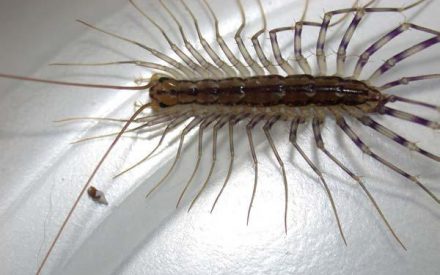 Centipedes
Centipedes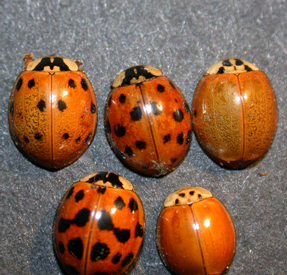 Multicolored Asian Lady Beetle
Multicolored Asian Lady Beetle


